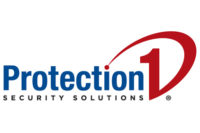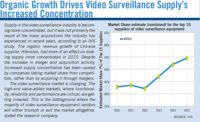Select Security, Lancaster, Pa., founded in 1998 by industry veteran Patrick Egan, is a full-service residential and commercial security company. The company was reorganized in 2003 to focus as a super regional security dealer in central Pennsylvania. In these the past 10 years, the company has worked hard to grow within its region, averaging a 30 percent growth in recurring monthly revenue (RMR) for the past three years. Looking to the future and the challenges facing all security companies in keeping up with technology advances both in product lines and back-end productivity, the company decided to take a hard look at its enterprise resource planning (ERP) system and how it could enhance the efforts of its people.
The company has surpassed $650,000 a month in RMR and currently sits at No. 59 on the SDM 100, having steadily climbed up the rankings for the past four years.
Steve Firestone, executive vice president at Select Security commented that upon taking a close look at its old ERP system last year, concerns grew that the system was not supportive of the kind of growth the company wanted to continue to see. “We’ve been fortunate that our attrition has been incredibly low,” Firestone said. “But it’s been incredibly low in large part because of the efforts of humans, not data. So when you marry accurate data with people who work really hard at satisfying the customer, then I think you can sustain that kind of growth for a long period of time.”
Key Data Deficiencies Impeding Growth
“Like many security dealers, we felt like we didn’t know enough about our customers,” Firestone said. He explained the company felt a lack of knowledge could cause it to come up short on customer experiences. At the same time, it could mean missed opportunities for maximizing recurring monthly revenue. The company also felt that it wasn’t learning enough from its existing customer base to grow in the vertical markets where it operated with new relationships. “We just didn’t know enough about our customers to be able to leverage 10 years worth of experience to grow the business organically,” Firestone continued. “That was kind of reason number one for taking a look at whether we were getting enough out of our existing ERP system.”
The company also believed it was missing opportunities to streamline operations and find out how to run more efficiently.
Realizing Cooperative Evaluation
In the fourth quarter of last year, the company began its assessment of ERP systems specific to the security industry that would provide the reliable data the company was looking for. The companies were carefully vetted and narrowed down by the executive team.
As the final step of its evaluation, Select Security established task force groups that were led by someone from each one of the disciplines within the organization. Representatives from accounting, installation, inspections, customer care, etc. led a cross-departmental task force to weigh in on the final options and then to lead the integration once the decision was made to purchase SedonaOffice.
“We had six or seven of those task force teams established led by someone (generally from middle management) who actually participated in the final evaluation of whether SedonaOffice was the right selection, Firestone said.
The company felt that the buying and implementation of a new ERP system was a “culture-changing initiative” as it would change the way it did business. Therefore, the decision to involve the people closest to making day-to-day operational decisions early on was the best possible move, Firestone commented.
By the end of 2012, the company’s management and task groups decided that SedonaOffice was the right option.
The Migration Plan
Select Security took a very disciplined approach to introducing SedonaOffice to its organization. That approach, which goes back several months before the migration actually started in May, 2013, was critical in the level of adoption for each one of the departments that rely on the ERP system.
“Once the decision was made to go with SedonaOffice, it was those task force teams that were in regular — and when I say regular I’m talking about several times a week — dialogue with SedonaOffice during the implementation process.” Firestone explained. “So decisions that were made as to how we were going to use SedonaOffice and how it was going to change our business operation were not made by the executive management team, they were made by the people that were actually going to be using SedonaOffice in the operation of their jobs.”
The challenge in changing something as integral to a security company’s everyday operations as the back-end software system — and setting it up to work optimally — is that it takes time. Firestone said the overused phrase “garbage in, garbage out” applied. “If one field is supposed to map to a corresponding field in SedonaOffice and you have it in the wrong field in the preceding ERP, it’s going to map wrong into SedonaOffice.” Therefore, the first step in the migration, and possibly the most painstaking, was to comb through data in the old system to make sure the information in any given field was actually relevant to it. “Because if it’s not you’ll get bad data in the new ERP system,” Firestone explained.
The day the conversion took place was a game-changer in every sense of the word, according to Firestone, and that was the day the real work started, he noted. “The 100 days before is cleaning up the data. The 100 days after is saying, ‘Ok, now we have software that works, now we’ve got to make sure that we rewrite all of our procedures and all of our processes to take advantage of how the new software works.’ It’s rewriting everything from how we bill, to how we dispatch, to how we track inventory, etc.”
Creating New Opportunities for Growth
When Select Security embarked on this process to change its ERP system at the beginning of 2013, many recognized the work ahead as a learning opportunity. One of the fortunate side effects of each department spending significant time and effort closely looking at procedures would be gaining valuable insight into the business that perhaps hadn’t surfaced in the previous 10 years.
With its old ERP system, Select Security was not able to capture accurate data to easily schedule recurring inspections. During the exhaustive audit process prior to migrating to SedonaOffice, the company discovered that was gap in its procedure. Now, through the SedonaSync module, the company is able to automatically notify the appropriate people when the next inspection is due for a customer. The system creates reports, schedules the inspections within the service module, and can notify the corresponding salesman through email or text message, with the information residing in a single place.
“Another example is we’ve not historically been able to track the frequency of go-backs on service calls,” Firestone continued. “Go-backs are not a good thing for us or the customer. Through [the Service module], we’re now able to not only track go-backs, but look at root causes of go-backs and change our procedures on who’s dispatched, when, and with what inventory on a vehicle based on what that service call needs to accomplish in a way that we were never able to do previously.”
Meanwhile, employees all across the organization, so many of which contributed to the decision to switch to SedonaOffice and helped orchestrate the migration to it, have offered three kinds of feedback, Firestone observed: “The first is, ‘You were right. We learned a heck of a lot about our business that we didn’t know before.’ The second is, ‘Oh my gosh, we very much underestimated how difficult this would be because of the magnitude of an ERP conversion. Thank goodness SedonaOffice has been through this hundreds of times, because this is the only time we’ve gone through it.’ They have been — and I’m not saying this as a SedonaOffice commercial — terrific having gone through it as many times as they have. But for a company like ours where we are pushing decisions and involving people way down in the organization, it’s a huge commitment of time. And by committing the time and engaging them early on you get the third reaction, which is, ‘This is so much better than we had hoped it would be.’”
PROJECTS in the News
At sister properties Casino Arizona and Talking Stick Resort in Scottsdale, Arizona, the Morse Watchmans KeyWatcher® key control system is used to store, control and track keys that are used for access to all the most sensitive and highly secured areas of the casinos where money and chips are held, including the slot department and cages. A KeyWatcher key system is also used by the casinos’ security departments to store and track keys needed throughout the facilities. Designed for optimum key security, KeyWatcher key control cabinets will not open until the system verifies that the user has permission for the specific key requested and the system automatically records all activity.
“We like that we have key accountability and tracking of all keys on-site with the KeyWatcher system,” said Roxanne Manwell, access control supervisor, Casino Arizona and Talking Stick Resort. “It alerts us when keys are not turned in correctly and/or are overdue and we can send out the report to the departments for notification purposes.”
The KeyWatcher system and accompanying KeyPro™ software, in place since 2004, enable Casino Arizona and Talking Stick Resort to meet the various Arizona Indian Gaming Statutes regarding key control and management. Custom software enables the casinos to set up all these and many other types of reports, which can be emailed to management on a regular basis.
PNY, an electronics manufacturer and a global player in the consumer electronics market, used 21 Avigilon HD cameras to help secure its corporate headquarters, which spans 38 acres with a 600,000-square-foot manufacturing plant in Parsippany, NJ. When the company moved in to the manufacturing plant, not only did the machines need to be upgraded or replaced, but the management team also wanted to deploy a new IP surveillance system to protect the company’s inventory from theft, safeguard the warehouse’s 500 employees and improve daily business and safety practices. Avigilon 5 MP cameras monitor various areas within PNY’s manufacturing warehouse including the company’s assembly areas, packaging lines and shipping. PNY deploys Avigilon 16 MP cameras to oversee activity outside of the building as well as the parking lots. The security team at PNY manages the system from their on-site security control center and uses ACC Mobile to view live and recorded images remotely and Avigilon Network Video Recorders (NVRs) to store up to 30 days of continuous surveillance footage.
■ ■ ■
Smarter Security Inc., provider of entrance control and outdoor security solutions, announced that a leading social media company completed an internal pilot this year of Door Detective® Compact and standardized on Door Detective to enhance door security with tailgate detection. The customer has since placed three orders for Door Detective for locations on the west coast and in Canada, and most recently for an office building on the east coast.
“We are excited to be working with this customer that sees the value in upgrading doorway access control for many of its business locations,” said Jeff Brown, chief executive officer of Smarter Security. “Technology companies frequently have valuable intellectual property or sensitive data that makes it worth spending a little bit more to dramatically increase the protection level. Accountability is critical.”
The most recent order by the social media company was for a single unit of Smarter Security’s Door Detective CL to help secure the entry to a data center on the east coast. Previous orders totaling eight units were all for compact models, favored by this customer due to aesthetics, which were used for tailgate detection on suite entry doors in multi-tenant buildings. Concerns about the security risk in shared-space buildings prompted the customer to conduct the initial Door Detective pilot.
■ ■ ■
Digital Identification Solutions (DISO), a leading international ID solutions provider, announced the recent purchase of EDIsecure® XID 9300 printers to be used by a major international airport and its hubs. These specific XID printers feature high-quality retransfer printing technology as well as magnetic stripe and contact chip encoding options.
The airport system, which owns and operates three locations in California, was unhappy with the previous printers due to irregularity and service issues. When DISO’s local channel partner, CI Solutions, demonstrated several printers in live testing, EDIsecure® printers were selected due to overall reliability and ease of use.
Bill Potwin, Digital Identification Solutions’ sales manager for North America, said, “We are very excited to have our printers in the airports of one of the world’s most populous metropolitan areas. As some of the busiest airports in the country, our XID 9300 printers will provide the reliability they need without sacrificing quality.”
Comprised of a professional administrative staff of nearly 3,500 employees, the airport system will use the printers to provide personnel with multifunctional identification cards. Due to the sheer volume of cards needed, as well as the various security levels issued, the company required a dependable, modular solution like the XID 9300, DISO reported.









